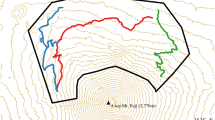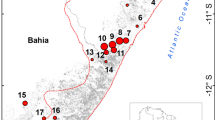Abstract
Data from an Ethiopian population of Colobus guerezashow that territory size is fixed by the high density of the population. Groups undergo fission when their size results in fewer than 10 trees per individual within the group’s territory. The daughter groups produced by fission emigrate into suboptimal habitat, which acts as a demographic sink. Comparative analyses using data from other East African populations demonstrate that mean territory size is inversely related to population density and that density, in turn, is a function of the size of the forest block. Since both group size and reproductive rates can be shown to be positively correlated with type of forest, it is concluded that this relationship reflects the fact that local population densities reach their ceiling more rapidly in small forest blocks because the animals’ access to alternative territories is limited. The number of males in a colobus group is shown to be a function of the number of females in it. Multimale groups have lower reproductive rates than one-male groups, probably because the stress generated by competition among the males causes temporary infertility among the females.
Similar content being viewed by others
References
Abbott, D. H., (1984). Behavioral and physiological suppression of fertility in subordinate marmoset monkeys.Am. J. Primatol. 6: 169–186.
Abbott, D. H., Keverne, E. B., Moore, G. F., and Yodyingyuad, U. (1984). Social suppression of reproduction in subordinate talapoin monkeys,Miopithecus talapoin. Int. J. Primatol. 5: 318.
Anderson, C. M. (1981). Subtrooping in a chacma baboon (Papio ursinus) population.Primates 23: 445–458.
Bauchop, T. (1978). Digestion of leaves in vertebrate arboreal folivores. In Montgomery, C. G. (ed.),The Ecology of Arboreal Folivores, Smithsonian Institution Press, Washington, D.C., pp. 193–204.
Bowman, L. A., Dilley, S. R., and Keverne, E. B. (1978). Suppression of oestrogen-induced LH surges by social subordination in talapoin monkeys.Nature (London) 275: 56–58.
Caldecott, J. O. (1986).An Ecological and Behavioural Study of the Pig-Tailed Macaque, Karger, Basel.
Clutton-Brock, T. H. (1974). Primate social organisation and ecology.Nature (London) 250: 539–542.
Clutton-Brock, T. H., and Harvey, P. H. (1977). Primate ecology and social organisation.J. Zool. (London) 183: 1–39.
De Moor, P. P., and Steffens, F. E. (1972). The movements of vervet monkeys (Cercopithecus aethiops) within the ranges as revealed by radiotracking.J. Anim. Ecol. 41: 677–687.
de Ruiter, J. R. (1986). The influence of group size on predator scanning and foraging behaviour of wedgecapped capuchin monkeys (Cebus olivaceus).Behaviour 98: 240–258.
Dunbar, R. I. M. (1980). Determinants and evolutionary consequences of dominance among female gelada baboons.Behav. Ecol. Sociobiol. 7: 253–265.
Dunbar, R. I. M. (1987).Primate Social Systems, Croom Helm, Beckenham, Kent, and Cornell University Press, Ithaca, N.Y.
Dunbar, R. I. M., and Dunbar, P. (1974a). Ecology and population dynamics ofColobus guereza in Ethiopia.Folia primatol. 21: 188–208.
Dunbar, R. I. M., and Dunbar, P. (1974b). Ecological relations and niche separation between sympatric terrestrial primates in Ethiopia.Folia primatol. 21: 36–60.
Dunbar, R. I. M., and Dunbar, P. (1978). Contrasts in social structure among black-and-white colobus monkey groups.Anim. Behav. 24: 84–92.
Emlen, S. T., and Oring, L. W. (1977). Ecology, sexual selection and the evolution of mating systems.Science 197: 215–223.
Frame, L. H., and Frame, G. A. (1976). Female African wild dogs emigrate.Nature (London) 263: 227–229.
Freeland, W. J. (1979). Mangabey (Cercocebus albigena). Social organisation and population density in relation to food use and availability.Folia primatol. 32: 108–124.
French, J. A., Abbott, D. H., and Snowdon, C. T. (1984). The effect of social environment on estrogen excretion, scent marking and sociosexual behavior in tamarins (Saguinus oedipus).Am. J. Primatol. 6: 155–167.
Harcourt, A. H. (1978). Strategies of emigration and transfer by primates: With particular reference to gorillas.Z. Tierpsychol. 48: 401–420.
Harcourt, A. H., Stewart, K., and Fossey, D. (1976). Male emigration and female transfer in wild mountain gorilla.Nature (London), 263: 226–227.
Holmes, R. T. (1970). Differences in population density, territoriality and food supply of dunlin on arctic and subarctic tundra. In Watson, A. (ed.),Animal Populations in Relation to Their Food Resources, Blackwell, Oxford, pp. 303–319.
Hrdy, S. B. (1974). Male-male competition and infanticide among the langurs (Presbytis entellus) of Abu, Rajasthan.Folia primatol. 22: 19–58.
Huxley, J. S. (1934). A natural experiment on the territorial instinct.British Birds 27: 270–277.
Ikeda, H. (1982). Population changes and ranging behaviour of wild Japanese monkeys at Mt. Kawaradake in Kyushu, Japan.Primates 23: 338–347.
Iwamoto, T., and Dunbar, R. I. M. (1983). Thermoregulation, habitat quality and the behavioural ecology of gelada baboons.J. Anim. Ecol. 52: 357–366.
Kay, R. N. B., Hoppe, P., and Maloiy, G. M. O. (1976). Fermentative digestion of food in the colobus monkey,Colobus polykomos. Experientia 32: 485–486.
King, J. A. (1955). Social behavior, social organization and population dynamics in a black-tailed prairiedog town in the Black Hills of South Dakota.Contrib. Lab. vert. Biol. Univ. Mich. 67: 1–123.
Kinzey, W. G. (1977). Diet and feeding behaviour ofCallicebus torquatus. In Clutton-Brock, T. H. (ed.),Primate Ecology, Academic Press, London, pp. 127–151.
Le Beouf, B. J. (1974). Male-male competition and reproductive success in elephant seals.Am. Zool. 14: 163–176.
Marier, P. (1969).Colobusguereza: territoriality and group composition.Science 163: 93–95.
Marsh, C. W. (1979a). Female transference and mate choice among Tana River red colobus.Nature (London) 14: 163–176.
Marsh, C. W. (1979b). Comparative aspects of social organisation in the Tana River red colobus,Colobus badius rufomitratus. Z. Tierpsychol. 51: 337–362.
Marsh, C. W. (1981). Ranging behaviour and its relation to diet selection in Tana River red colobu-(Colobus badius rufomitratus).J. Zool. (London) 195: 473–492.
Mason, W. A. (1968). Use of space byCallicebus groups. In Jay, P. (ed.),Primates, Holt, Rinehart and Winston, New York. pp. 200–216.
Mènard, N., Vallety, D., and Gautier-Hion, A. (1985). Démographie et reproduction deMacaca sylvanus dans differents habitats en Algerie.Folia primatol. 44: 65–81.
Milton, K., and May, M. L. (1976). Body weight, diet and home range area in primates.Nature (London) 259: 459–462.
Moore, J. (1984). Female transfer in primates.Int. J. Primatol. 5: 537–589.
Myers, J. P., Connors, P. G., and Pitelka, F. A. (1979). Territory size in wintering sanderling: the effects of prey abundance and intruder density.Auk 96: 551–561.
Newton, P. N. (1986). Infanticide in an undisturbed forest population of hanuman langurs,Presbytis entellus. Anim. Behav. 34: 785–789.
Oates, J. F. (1977a). The guereza and its food. In Clutton-Brock, T. H. (ed.),Primate Ecology, Academic Press, London, pp. 275–321.
Oates, J. F. (1977b). The social life of a black-and-white colobus monkey,Colobus guereza. Z. Tierpsychol. 45: 1–60.
Oates, J. F. (1977c). The guereza and man: how man has affected the distribution and abundance ofColobusguereza and other black colobus monekeys. In H. S. H. Prince Raini-er of Monaco and Bourne, G. H. (eds.).Primate Conservation, Academic Press, New York, pp. 419–467.
Oates, J. F. (1978). Water-plant and soil consumption by guereza monkeys (Colobus guereza): A relationship with minerals and toxins in the diet?Biotropica 10: 241–253.
Ohsawa, H., and Dunbar, R. I. M. (1984). Variations in the demographic structure and dynamics of gelada baboon populations.Behav. Ecol. Sociobiol. 15: 231–240.
Rose, M. D. (1978). Feeding and associated positional behavior of black and white colobus monkeys (Colobus guereza). In Montgomery, C. G. (ed.),The Ecology of Arboreal Folivores, Smithsonian Institution Press, Washington, D.C.
Schenkel, R., and Schenkel-Hulliger, L. (1967). On the sociology of free-ranging colobus (Colobus guereza caudatus Thomas 1885). In Starck, D., Schneider, R., and Kuhn, H. J. (eds.),Progress in Primatology, Karger, Basel, pp. 185–194.
Sharman, M., and Dunbar, R. I. M. (1982). Observer bias in selection of study group in baboon field studies.Primates 23: 567–573.
StengerWeeden, J. (1965). Territorial behaviour of the tree sparrow.Condor 67: 193–209.
Struhsaker, T. T. (1967). Ecology of vervet monkeys (Cercopithecus aethiops) in the Masai-Amboseli game reserve, Kenya.Ecology 48: 891–904.
Struhsaker, T. T., and Leland, L. (1985). Infanticide in a patrilineal society of red colobus monkeys.Z. Tierpsychol. 69: 277–281.
Suzuki, A. (1979). The variation and adaptation of social groups of chimpanzees and black and white colobus monkeys. In Bernstein, I., and Smith, E. O. (eds.).Primate Ecology and Human Origins, Garland STPM, New York, pp. 153–173.
Takasaki, H. (1981). Troop size, habitat quality and home range area in Japanese macaques.Behav. Ecol. Sociobiol. 9: 277–281.
Ullrich, W. (1961). Zur Biologie and Soziale der Colobusaffen (Colobus guereza caudatus Thomas 1885).Zool. Gart. Lpz. 25: 305–368.
van Schaik, C. P. (1983). Why are diurnal primates living in groups?Behaviour 87: 120–144.
van Schaik, C. P., van Noordwijk, M. A., de Boer, R. J., and den Tonkelaar, I., (1983). The effects of group size on time budgets and social behaviour in wild long-tailed macaques (Macaca fascicularis).Behav. Ecol. Sociobiol. 13: 173–181.
Waser, P. M. (1977). Feeding, ranging and group size in the mangabey,Cercocebus albigena. In Clutton-Brock, T. H. (ed.),Primate Ecology, Academic Press, London, pp. 182–222.
Wasser, S. K., and Barash, D. P. (1983). Reproductive suppression among female mammals: Implications for biomedicine and sexual selection theory.Q. Rev. Biol. 58: 513–538.
Wrangham, R. W., and Smuts, B. B. (1980). Sex differences in the behavioural ecology of chimpanzees in the Gombe National Park, Tanzania.J. Reprod. Fertil. Suppl. 28: 13–31.
Author information
Authors and Affiliations
Rights and permissions
About this article
Cite this article
Dunbar, R.I.M. Habitat quality, population dynamics, and group composition in Colobus Monkeys (Colobus guereza). Int J Primatol 8, 299–329 (1987). https://doi.org/10.1007/BF02737386
Received:
Revised:
Issue Date:
DOI: https://doi.org/10.1007/BF02737386




